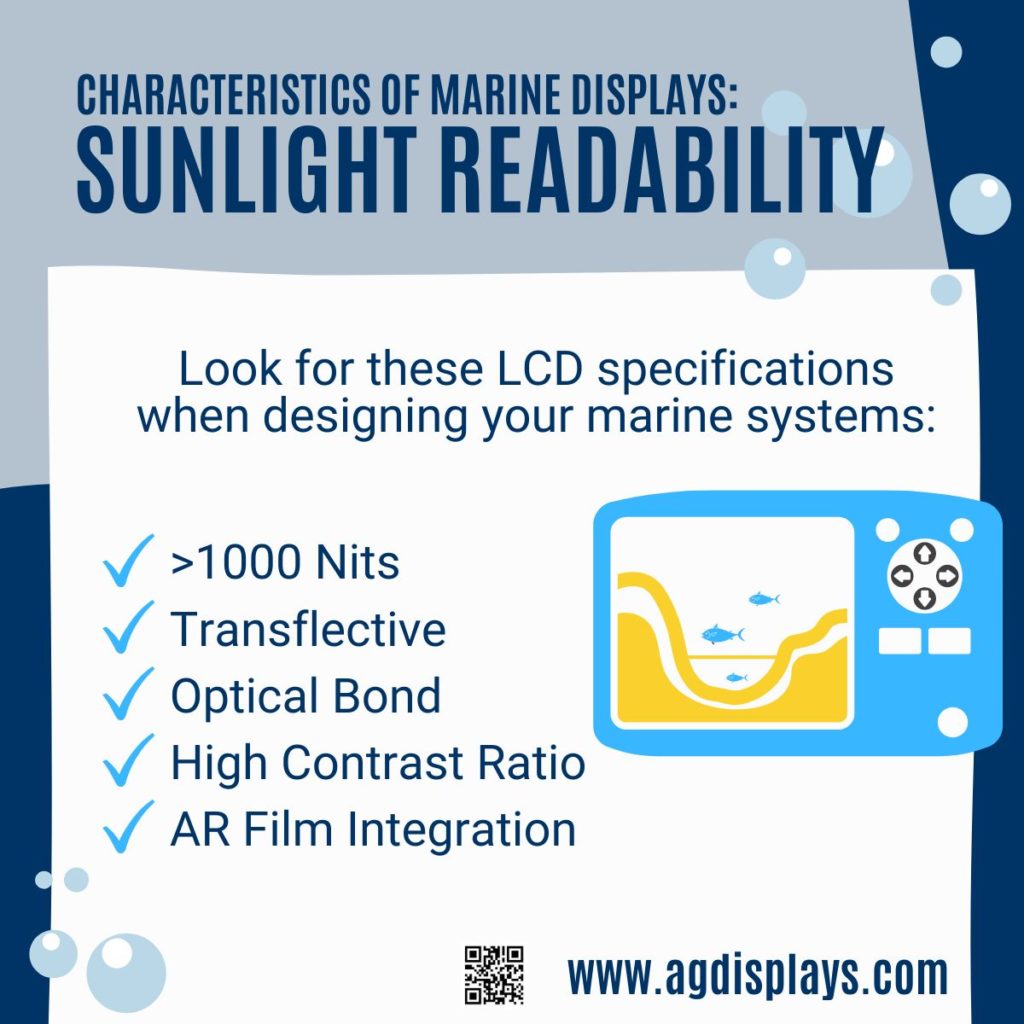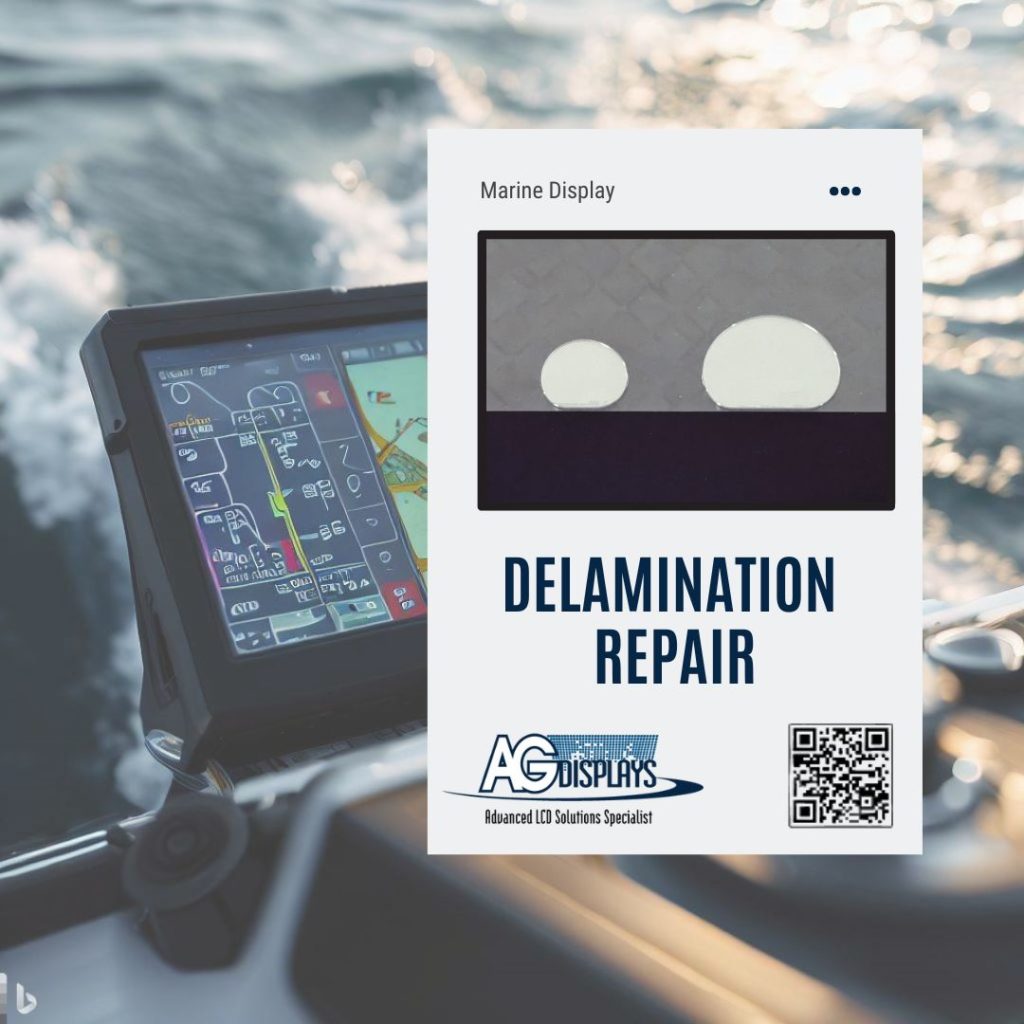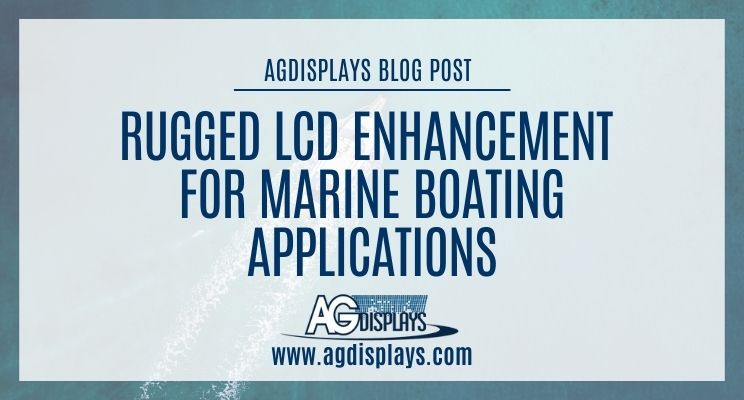In the world of marine boating, having reliable and durable displays is crucial for a seamless and safe experience. AGDisplays understands these needs and offers cutting-edge solutions to enhance marine boating displays. Below, we will explore how AGDisplays’ rugged LCD enhancement can elevate your marine boating displays, including a special focus on our delamination repair for the Medallion brand displays and other displays affected by delamination.
Unmatched Durability for Marine Environments
AGDisplays’ rugged LCD enhancement is engineered to excel in the harshest marine environments. These displays are built with reinforced panels, robust housing, and advanced sealing technologies, ensuring they can withstand extreme temperatures, high humidity, saltwater exposure, and constant vibrations. With their exceptional durability, AGDisplays’ displays provide long-lasting performance, making them ideal for marine boating applications.
Optimal Visibility in Any Lighting Condition
When you’re out at sea, visibility is critical. AGDisplays’ rugged LCD enhancement is equipped with advanced anti-glare and anti-reflective coatings, ensuring optimal visibility even in bright sunlight. These displays also offer high brightness levels, allowing for clear and vivid imagery in various lighting conditions. Whether you’re navigating, monitoring systems, or enjoying entertainment, AGDisplays’ displays deliver unparalleled visibility for an enhanced boating experience.
Our most advanced and popular Marine Displays include our High Bright Displays with PWM Voltage Control, but how do they work?
High bright LCD displays with PWM controllable LED controllers are a type of LCD display technology that provides superior brightness and clarity in outdoor or bright environments. PWM stands for Pulse Width Modulation, which is a technique used to control the brightness of the LED backlighting in LCD displays.
In high bright LCD displays, the LED backlighting is typically brighter than in standard displays, which allows the display to maintain its clarity and visibility even in direct sunlight or bright conditions. The PWM controllable LED controllers provide precise control over the brightness levels of the LED backlighting, allowing for efficient power management and the ability to adjust the brightness as needed for different lighting conditions.
In marine boating applications, high bright LCD displays with PWM controllable LED controllers are especially beneficial due to the challenging outdoor and water environments. The bright sun and glare on the water can make it difficult to see traditional displays, but high bright displays with their increased brightness and clarity make them easy to read even in these conditions.
Furthermore, PWM controllable LED controllers allow for efficient power management, which is important for marine boating applications where power supply can be limited or unreliable. By adjusting the brightness levels of the LED backlighting, users can conserve battery power and extend the life of their displays.
Overall, high bright LCD displays with PWM controllable LED controllers are a valuable investment for marine boating applications, providing improved visibility and power efficiency in challenging outdoor environments. AGDisplays offers a range of high bright displays with PWM controllable LED controllers, as well as customization options to meet specific needs and requirements.

Enhanced Touchscreen Capabilities for Intuitive Interaction
Effortless interaction with marine boating displays is essential. AGDisplays’ rugged LCD enhancement features advanced touchscreen technologies that provide precise and responsive touch inputs. These touchscreens are designed to offer intuitive control, whether you’re navigating through charts, adjusting settings, or accessing multimedia. What’s more, they are operable with wet or gloved hands, ensuring usability even in challenging marine conditions.
Typically AGDisplays with employ the use of either PCAP or Resistive touch screen technology, depending on the precise application and needs of the customer. Both touch technologies provide benefits for marine applications, but what are they?
PCAP Touch Screen Technology:
Multi-Touch Capability: PCAP touch screens support multi-touch gestures, allowing users to interact with the display using multiple fingers simultaneously. This enables intuitive pinch-to-zoom, swipe, and rotation gestures, similar to smartphone or tablet interactions. Multi-touch capability enhances the user experience by providing more natural and efficient navigation.
High Sensitivity and Responsiveness: PCAP touch screens are highly sensitive and responsive, accurately detecting even the slightest touch. This ensures precise and immediate input recognition, minimizing any delays or inaccuracies in user interactions. The high responsiveness of PCAP touch screens enhances the overall usability and fluidity of marine boating displays.
Optical Clarity and Durability: PCAP touch screens offer excellent optical clarity since they typically consist of a single glass layer without additional layers that could distort the display. This ensures superior image quality and readability, even in bright sunlight or harsh lighting conditions. Additionally, PCAP touch screens are durable and resistant to scratches and impacts, making them well-suited for rugged marine environments.
Resistive Touch Screen Technology:
Pressure Sensitivity: Resistive touch screens respond to pressure, allowing input from various objects such as fingers, gloved hands, or styluses. This versatility is particularly advantageous in marine boating applications where users may be wearing gloves or dealing with wet conditions. The ability to operate resistive touch screens with different inputs enhances usability and accessibility.
Wide Compatibility: Resistive touch screens are compatible with a wide range of styluses or non-conductive objects, making them suitable for precise and detailed interactions. This feature is beneficial in scenarios where users need to make accurate selections or annotations on the display, such as when marking waypoints on navigation charts or inputting data in forms.
Robustness and Reliability: Resistive touch screens are known for their robustness and resistance to harsh environments. They can withstand water exposure, dirt, dust, and vibrations commonly experienced in marine boating settings. This durability ensures reliable performance and longevity, making resistive touch screens a suitable choice for rugged marine applications. Both PCAP and resistive touch screen technologies have their strengths and advantages, and the choice depends on the specific requirements and preferences of the marine boating application. AGDisplays offers customization options for touch screen technologies, allowing customers to select the most appropriate solution for their marine boating displays.
AGDisplays’ Delamination Repair for Medallion Brand Displays
AGDisplays also offers a specialized delamination repair service for Medallion brand displays. Delamination, a common issue in LCD displays, occurs when layers of the display separate, leading to reduced image quality and performance. AGDisplays’ experienced technicians can repair and restore Medallion brand displays affected by delamination, extending their lifespan and saving customers the cost of replacement. This service ensures that boaters can continue to rely on their Medallion displays with restored functionality and visual clarity.

How does the delamination repair process work?
LCD delamination repair refers to the process of restoring or fixing a liquid crystal display (LCD) panel that has experienced delamination. Delamination occurs when the layers of an LCD display separate or detach from each other, resulting in visible defects such as bubbles, spots, or discoloration on the screen. Delamination can occur due to various factors, including manufacturing defects, environmental conditions, or physical damage.
The delamination repair process typically involves the following steps:
Inspection and Assessment: An expert technician examines the delaminated LCD panel to assess the extent of the damage and determine the feasibility of repair. They analyze the affected areas, identify the layers that have separated, and evaluate any underlying causes of delamination.
Disassembly: In order to repair the delaminated LCD panel, it needs to be disassembled. This process requires careful handling to avoid further damage. The technician removes the display module from its housing and separates the layers of the panel.
Cleaning and Preparation: Once disassembled, the separated layers of the LCD panel are thoroughly cleaned to remove any debris, adhesives, or contaminants. Cleaning is crucial to ensure proper bonding during the repair process. Specialized cleaning agents and techniques are used to maintain the integrity of the delicate layers.
Reapplication of Optical Materials: After cleaning, the technician carefully applies a specialized optical adhesive or bonding material to the affected layers. This adhesive helps to reattach the delaminated layers, restoring the structural integrity of the LCD panel. The adhesive selected should be compatible with the specific layers and components of the panel.
Bonding and Curing: The layers of the LCD panel are then carefully realigned and bonded together using pressure and heat. The panel is placed in a controlled environment, often using a vacuum chamber, to ensure proper bonding and eliminate any trapped air or impurities. The bonding process may involve the use of precision tools and equipment to maintain alignment and even pressure distribution.
Quality Assurance and Testing: Once the bonding process is complete, the repaired LCD panel undergoes rigorous quality assurance checks and testing. This may include visual inspection, functionality testing, color calibration, and other performance evaluations to ensure that the repaired panel meets the required standards and functions optimally.
Reassembly and Integration: After successful repair and testing, the LCD panel is reassembled into its original housing or enclosure. The technician carefully reconnects any cables, ribbon connectors, or other components to ensure proper functionality. The repaired panel is then integrated back into the marine boating display system.
It’s important to note that LCD delamination repair requires specialized skills, equipment, and expertise. It is typically performed by trained professionals with experience in LCD panel repairs. Additionally, not all LCD delamination cases can be successfully repaired, especially if the damage is extensive or if the underlying cause of delamination is severe.
By undergoing LCD delamination repair, boaters can restore the functionality and visual quality of their displays, saving the cost of complete replacement and minimizing downtime. AGDisplays’ specialized delamination repair service, including their expertise in repairing Medallion brand displays, offers boaters a reliable solution to address delamination issues and restore the performance of their marine boating displays.

Conclusion
AGDisplays’ rugged LCD enhancement provides the ultimate solution for enhancing marine boating displays. With unparalleled durability, optimal visibility, enhanced touchscreen capabilities, and their specialized delamination repair service for Medallion brand displays, AGDisplays empowers boaters with robust and resilient displays. Elevate your marine boating experience today with AGDisplays’ cutting-edge technology.

